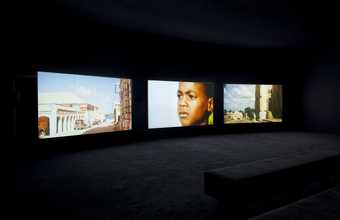
Sir John Akomfrah CBE
The Unfinished Conversation
(2012)
Tate
Our role at Tate is to share art in all its complexity and diversity. In recent years we have made progress in better representing artists of colour in our collection and our programmes, but that work must go much further. We know, too, that not everyone has equal access to art and its benefits. We are committed to changing this through our work, and to challenging ourselves to dismantle the structures within our own organisation which perpetuate that inequality.
The founding of our gallery and the building of its collection are inextricably connected to Britain’s colonial past, and we know there are uncomfortable and inappropriate images, ideas and histories in the past 500 years of art which need to be acknowledged and explored. We also recognise the intersections of race, gender, sexuality and class in the experience of inequality.
These are not new aims for Tate. We have a stated objective to become a more inclusive institution that reflects the world we live in now. But progress has not been fast or significant enough.
This page details Tate’s ongoing commitment to race equality. It will be regularly updated with information about what we are doing to address structural racism, charting our progress towards becoming a more inclusive organisation as part of an open and transparent process. It uses ‘Black, Asian and/or minority ethnic (BAME)’ as a signifier, however we recognise the discomfort that this terminology produces in reducing individuals of diverse heritage to a single category, and we are working to address this.
September 2024
Developments since our last update include:
- Sessions for senior leaders have been completed with a focus on supporting and accelerating Tate’s ongoing commitment to race equality. A series of workshops, coaching and learning opportunities were delivered, with all of Tate’s Directors participating in at least one element of the programme.
- Tate’s annual Workforce Diversity Profile for 2023-24 has been published online, tracking progress towards having a workforce that more closely reflects the communities we serve. The latest figures show that 19% of staff for Tate Gallery identify within Asian, Black, Mixed or Other ethnic groups. For Tate Commerce this figure is 13% and for Tate Eats it is 32%.
- Tate’s programme in 2024 features several exhibitions and collection displays with themes relating to race, representation, and cultural heritage. These include Viva Voce, a new film installation at Tate Britain by renowned British artist Keith Piper, commissioned in response to Rex Whistler’s 1927 mural The Expedition in Pursuit of Rare Meats. Piper’s work directly addresses Whistler’s artistic intentions and explores the social and political context of 1920s Britain. In May, Alvaro Barrington unveiled a major new work for the annual Tate Britain Commission. The artist is known for works which evoke the sounds and colours - as well as the social and political backdrop - of his early life in Grenada in the Caribbean and Brooklyn in New York. At Tate Modern a survey of photographs by South African visual activist Zanele Muholi opened in June. The show documents and celebrates the lives of South Africa’s Black lesbian, gay, trans, queer and intersex communities.
- We have reviewed and updated the Race Equality Acquisition guidelines. Created in 2021, these ensure careful consideration of questions of equality, diversity and inclusion for all works proposed for acquisition into Tate’s collection. Recent acquisitions of British works include photography by Sir Horace Ové, paintings by Balraj Khanna, Hurvin Anderson, Li-Yuan Chia, sculpture by Alvaro Barrington, film and video by Zineb Sedira, Sin Wai Kin and the Frieze Artist Award 2023 winner Adam Farah-Saad. International acquisitions include photography by James Barnor, paintings by Amy Sherald, sculpture by Wangechi Mutu, film and video by Zheng Bo and the Frieze Artist Award 2023 winner Santiago Yahuarcani.
- The diversity profile across Tate galleries in 2023-24 has continued to trend upwards, with 16% of UK visitors from Black British, Asian British, Mixed or Other ethnic groups, compared with 14% in 2022-23 and 12% in 2021-2022. As in previous years, Tate Lates and Uniqlo Tate Play attracted a particularly high proportion of minoritised ethnicity visitors by welcoming an audience of local young people and families: 44% at Tate Britain lates, 39% at Tate Modern Lates and 32% at Uniqlo Tate Play. Across exhibitions, A World in Common and Isaac Julien also attracted a higher proportion of minoritised ethnicity visitors than other exhibitions (23% and 26% respectively).
Further actions and progress can be viewed in the dropdown sections below.
Updated 12 September 2024
